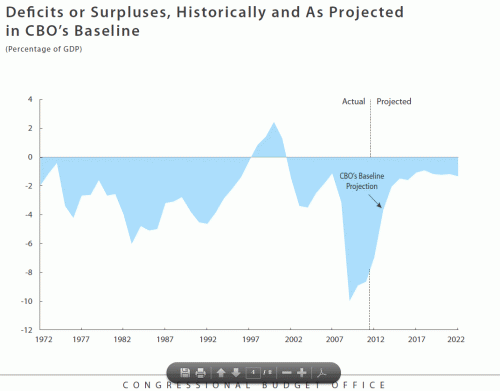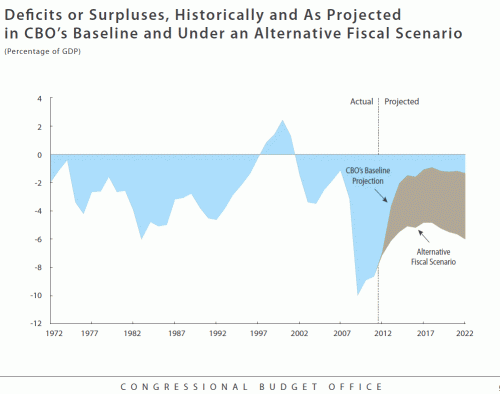If you can pick one thing in a policy argument, pick the baseline scenario against which to compare a series of policies.
The CBO’s baseline budgetary projections released this week show that the federal budget deficit will shrink greatly over the next few years. This is the so-called baseline scenario, that simply means that current law is followed. If you have a particular set of public policies you would like to enact, and you compare it to this scenario, it will be very hard for your policy tool kit to reduce the federal deficit in the next 10 years as compared to this baseline scenario because it contains some very large tax increases, and also some large spending reductions (Cuts from the Budget Control Act of 2011, Medicare payments to doctors).
However, I think there is almost no one who thinks all of the assumptions in the baseline projection will come to pass because it contains politically difficult things to enact.
So, the CBO also constructs an alternative fiscal scenario, that contains a mix of policies that might be viewed as more likely to come to pass. The alternative scenario assumes the following differences from the baseline shown above.
- all expiring tax provisions other than the payroll tax cut are extended
- AMT is indexed for inflation after 2011
- Medicare payments to physicians in Part B are held constant at current levels
- the automatic spending cuts from the Budget Control Act of 2011 do not take effect
The alternative fiscal scenario looks like this:
Deficit problem not fixed anymore, as deficits drop from the very large ones during the economic downturn, but begin to rise steadily again in the latter part of the decade as the tax receipts from our current tax code are unable to finance the default spending of our federal budget, particularly health care (Aaron points out we can’t get to sustainability via cutting discretionary spending).
I am not sure when, or even if, we will get a Grand Bargain to address the long run deficit issue. However, I am sure that if you can pick just one thing in the debate around these issues, pick the baseline against which to compare the policy options.
DT
update: Here are the slides CBO Director Elmendorf used in testimony to the House (figures above taken from there).



